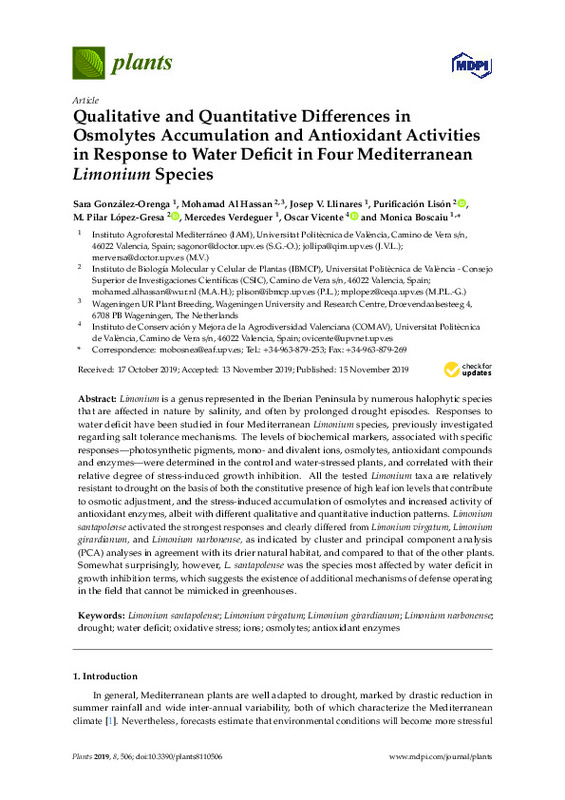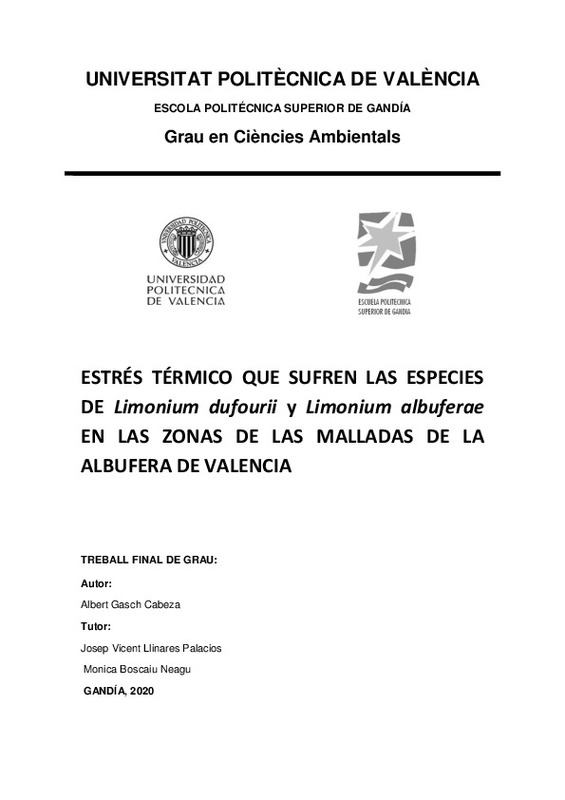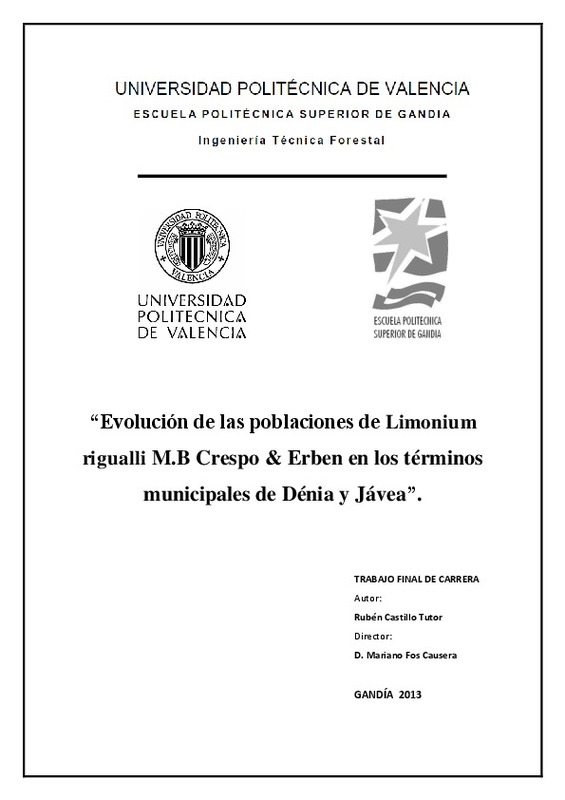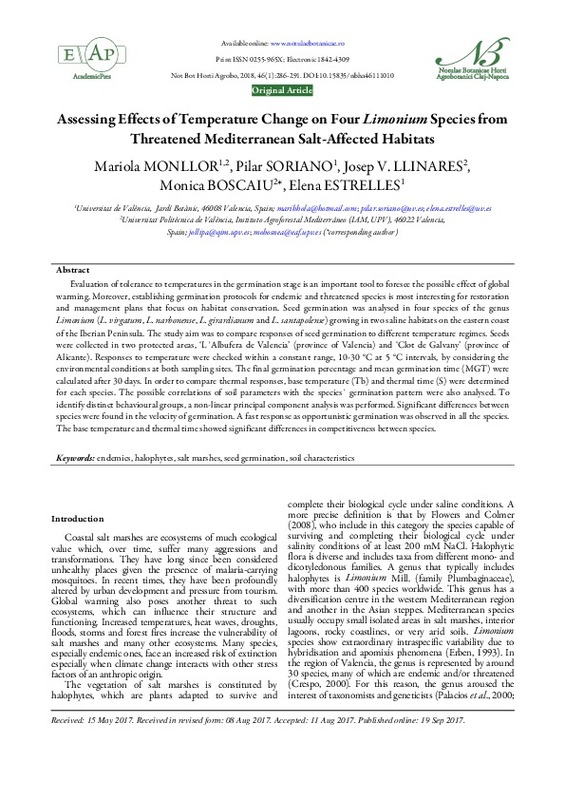JavaScript is disabled for your browser. Some features of this site may not work without it.
Buscar en RiuNet
Listar
Mi cuenta
Estadísticas
Ayuda RiuNet
Admin. UPV
Qualitative and Quantitative Dierences in Osmolytes Accumulation and Antioxidant Activities in Response to Water Deficit in Four Mediterranean Limonium Species
Mostrar el registro sencillo del ítem
Ficheros en el ítem
| dc.contributor.author | González-Orenga, Sara
|
es_ES |
| dc.contributor.author | Al Hassan, Mohamad
|
es_ES |
| dc.contributor.author | Llinares Palacios, Josep Vicent
|
es_ES |
| dc.contributor.author | Lisón, Purificación
|
es_ES |
| dc.contributor.author | López-Gresa, María Pilar
|
es_ES |
| dc.contributor.author | Verdeguer Sancho, Mercedes María
|
es_ES |
| dc.contributor.author | Vicente, Oscar
|
es_ES |
| dc.contributor.author | Boscaiu, Monica
|
es_ES |
| dc.date.accessioned | 2021-02-02T04:32:22Z | |
| dc.date.available | 2021-02-02T04:32:22Z | |
| dc.date.issued | 2019-11 | es_ES |
| dc.identifier.uri | http://hdl.handle.net/10251/160419 | |
| dc.description.abstract | [EN] Limonium is a genus represented in the Iberian Peninsula by numerous halophytic species that are a ected in nature by salinity, and often by prolonged drought episodes. Responses to water deficit have been studied in four Mediterranean Limonium species, previously investigated regarding salt tolerance mechanisms. The levels of biochemical markers, associated with specific responses¿photosynthetic pigments, mono- and divalent ions, osmolytes, antioxidant compounds and enzymes¿were determined in the control and water-stressed plants, and correlated with their relative degree of stress-induced growth inhibition. All the tested Limonium taxa are relatively resistant to drought on the basis of both the constitutive presence of high leaf ion levels that contribute to osmotic adjustment, and the stress-induced accumulation of osmolytes and increased activity of antioxidant enzymes, albeit with di erent qualitative and quantitative induction patterns. Limonium santapolense activated the strongest responses and clearly di ered from Limonium virgatum, Limonium girardianum, and Limonium narbonense, as indicated by cluster and principal component analysis (PCA) analyses in agreement with its drier natural habitat, and compared to that of the other plants. Somewhat surprisingly, however, L. santapolense was the species most a ected by water deficit in growth inhibition terms, which suggests the existence of additional mechanisms of defense operating in the field that cannot be mimicked in greenhouses. | es_ES |
| dc.description.sponsorship | This research was partially funded by Project AICO/2017/039 from the Generalitat Valenciana, granted to M. Boscaiu. | es_ES |
| dc.language | Inglés | es_ES |
| dc.publisher | MDPI | es_ES |
| dc.relation.ispartof | Plants | es_ES |
| dc.rights | Reconocimiento (by) | es_ES |
| dc.subject | Limonium santapolense | es_ES |
| dc.subject | Limonium virgatum | es_ES |
| dc.subject | Limonium girardianum | es_ES |
| dc.subject | Limonium narbonense | es_ES |
| dc.subject | Drought | es_ES |
| dc.subject | Water deficit | es_ES |
| dc.subject | Oxidative stress | es_ES |
| dc.subject | Ions | es_ES |
| dc.subject | Osmolytes | es_ES |
| dc.subject | Antioxidant enzymes | es_ES |
| dc.subject.classification | BIOQUIMICA Y BIOLOGIA MOLECULAR | es_ES |
| dc.subject.classification | EDAFOLOGIA Y QUIMICA AGRICOLA | es_ES |
| dc.subject.classification | BOTANICA | es_ES |
| dc.title | Qualitative and Quantitative Dierences in Osmolytes Accumulation and Antioxidant Activities in Response to Water Deficit in Four Mediterranean Limonium Species | es_ES |
| dc.type | Artículo | es_ES |
| dc.identifier.doi | 10.3390/plants8110506 | es_ES |
| dc.relation.projectID | info:eu-repo/grantAgreement/GVA//AICO%2F2017%2F039/ | es_ES |
| dc.rights.accessRights | Abierto | es_ES |
| dc.contributor.affiliation | Universitat Politècnica de València. Departamento de Ecosistemas Agroforestales - Departament d'Ecosistemes Agroforestals | es_ES |
| dc.contributor.affiliation | Universitat Politècnica de València. Departamento de Química - Departament de Química | es_ES |
| dc.contributor.affiliation | Universitat Politècnica de València. Instituto Universitario de Conservación y Mejora de la Agrodiversidad Valenciana - Institut Universitari de Conservació i Millora de l'Agrodiversitat Valenciana | es_ES |
| dc.contributor.affiliation | Universitat Politècnica de València. Departamento de Biotecnología - Departament de Biotecnologia | es_ES |
| dc.description.bibliographicCitation | González-Orenga, S.; Al Hassan, M.; Llinares Palacios, JV.; Lisón, P.; López-Gresa, MP.; Verdeguer Sancho, MM.; Vicente, O.... (2019). Qualitative and Quantitative Dierences in Osmolytes Accumulation and Antioxidant Activities in Response to Water Deficit in Four Mediterranean Limonium Species. Plants. 8(11):1-21. https://doi.org/10.3390/plants8110506 | es_ES |
| dc.description.accrualMethod | S | es_ES |
| dc.relation.publisherversion | https://doi.org/10.3390/plants8110506 | es_ES |
| dc.description.upvformatpinicio | 1 | es_ES |
| dc.description.upvformatpfin | 21 | es_ES |
| dc.type.version | info:eu-repo/semantics/publishedVersion | es_ES |
| dc.description.volume | 8 | es_ES |
| dc.description.issue | 11 | es_ES |
| dc.identifier.eissn | 2223-7747 | es_ES |
| dc.identifier.pmid | 31731597 | es_ES |
| dc.identifier.pmcid | PMC6918351 | es_ES |
| dc.relation.pasarela | S\397325 | es_ES |
| dc.contributor.funder | Generalitat Valenciana | es_ES |
| dc.description.references | Hoerling, M., Eischeid, J., Perlwitz, J., Quan, X., Zhang, T., & Pegion, P. (2012). On the Increased Frequency of Mediterranean Drought. Journal of Climate, 25(6), 2146-2161. doi:10.1175/jcli-d-11-00296.1 | es_ES |
| dc.description.references | Munns, R. (2002). Comparative physiology of salt and water stress. Plant, Cell & Environment, 25(2), 239-250. doi:10.1046/j.0016-8025.2001.00808.x | es_ES |
| dc.description.references | Van Breusegem, F., & Dat, J. F. (2006). Reactive Oxygen Species in Plant Cell Death. Plant Physiology, 141(2), 384-390. doi:10.1104/pp.106.078295 | es_ES |
| dc.description.references | Li, Z., Wakao, S., Fischer, B. B., & Niyogi, K. K. (2009). Sensing and Responding to Excess Light. Annual Review of Plant Biology, 60(1), 239-260. doi:10.1146/annurev.arplant.58.032806.103844 | es_ES |
| dc.description.references | Shabala, S., Bose, J., Fuglsang, A. T., & Pottosin, I. (2015). On a quest for stress tolerance genes: membrane transporters in sensing and adapting to hostile soils. Journal of Experimental Botany, 67(4), 1015-1031. doi:10.1093/jxb/erv465 | es_ES |
| dc.description.references | Schachtman, D. P., & Goodger, J. Q. D. (2008). Chemical root to shoot signaling under drought. Trends in Plant Science, 13(6), 281-287. doi:10.1016/j.tplants.2008.04.003 | es_ES |
| dc.description.references | Fang, Y., & Xiong, L. (2014). General mechanisms of drought response and their application in drought resistance improvement in plants. Cellular and Molecular Life Sciences, 72(4), 673-689. doi:10.1007/s00018-014-1767-0 | es_ES |
| dc.description.references | Martìnez, J. P., Ledent, J. F., Bajji, M., Kinet, J. M., & Lutts, S. (2003). Plant Growth Regulation, 41(1), 63-73. doi:10.1023/a:1027359613325 | es_ES |
| dc.description.references | Xi, J.-J., Chen, H.-Y., Bai, W.-P., Yang, R.-C., Yang, P.-Z., Chen, R.-J., … Wang, S.-M. (2018). Sodium-Related Adaptations to Drought: New Insights From the Xerophyte Plant Zygophyllum xanthoxylum. Frontiers in Plant Science, 9. doi:10.3389/fpls.2018.01678 | es_ES |
| dc.description.references | MILLER, G., SUZUKI, N., CIFTCI-YILMAZ, S., & MITTLER, R. (2010). Reactive oxygen species homeostasis and signalling during drought and salinity stresses. Plant, Cell & Environment, 33(4), 453-467. doi:10.1111/j.1365-3040.2009.02041.x | es_ES |
| dc.description.references | Sharma, P., Jha, A. B., Dubey, R. S., & Pessarakli, M. (2012). Reactive Oxygen Species, Oxidative Damage, and Antioxidative Defense Mechanism in Plants under Stressful Conditions. Journal of Botany, 2012, 1-26. doi:10.1155/2012/217037 | es_ES |
| dc.description.references | Kar, R. K. (2011). Plant responses to water stress: Role of reactive oxygen species. Plant Signaling & Behavior, 6(11), 1741-1745. doi:10.4161/psb.6.11.17729 | es_ES |
| dc.description.references | Golldack, D., Li, C., Mohan, H., & Probst, N. (2014). Tolerance to drought and salt stress in plants: Unraveling the signaling networks. Frontiers in Plant Science, 5. doi:10.3389/fpls.2014.00151 | es_ES |
| dc.description.references | Gagneul, D., Aïnouche, A., Duhazé, C., Lugan, R., Larher, F. R., & Bouchereau, A. (2007). A Reassessment of the Function of the So-Called Compatible Solutes in the Halophytic Plumbaginaceae Limonium latifolium . Plant Physiology, 144(3), 1598-1611. doi:10.1104/pp.107.099820 | es_ES |
| dc.description.references | Al Hassan, M., Estrelles, E., Soriano, P., López-Gresa, M. P., Bellés, J. M., Boscaiu, M., & Vicente, O. (2017). Unraveling Salt Tolerance Mechanisms in Halophytes: A Comparative Study on Four Mediterranean Limonium Species with Different Geographic Distribution Patterns. Frontiers in Plant Science, 8. doi:10.3389/fpls.2017.01438 | es_ES |
| dc.description.references | Galmés, J., Cifre, J., Medrano, H., & Flexas, J. (2005). Modulation of relative growth rate and its components by water stress in Mediterranean species with different growth forms. Oecologia, 145(1), 21-31. doi:10.1007/s00442-005-0106-4 | es_ES |
| dc.description.references | Galmés, J., Molins, A., Flexas, J., & Conesa, M. À. (2017). Coordination between leaf CO2diffusion and Rubisco properties allows maximizing photosynthetic efficiency inLimoniumspecies. Plant, Cell & Environment, 40(10), 2081-2094. doi:10.1111/pce.13004 | es_ES |
| dc.description.references | Guerin, G. R., Wen, H., & Lowe, A. J. (2012). Leaf morphology shift linked to climate change. Biology Letters, 8(5), 882-886. doi:10.1098/rsbl.2012.0458 | es_ES |
| dc.description.references | Kumar, D., Al Hassan, M., Naranjo, M. A., Agrawal, V., Boscaiu, M., & Vicente, O. (2017). Effects of salinity and drought on growth, ionic relations, compatible solutes and activation of antioxidant systems in oleander (Nerium oleander L.). PLOS ONE, 12(9), e0185017. doi:10.1371/journal.pone.0185017 | es_ES |
| dc.description.references | Marček, T., Hamow, K. Á., Végh, B., Janda, T., & Darko, E. (2019). Metabolic response to drought in six winter wheat genotypes. PLOS ONE, 14(2), e0212411. doi:10.1371/journal.pone.0212411 | es_ES |
| dc.description.references | Silva, E. N., Ferreira-Silva, S. L., Viégas, R. A., & Silveira, J. A. G. (2010). The role of organic and inorganic solutes in the osmotic adjustment of drought-stressed Jatropha curcas plants. Environmental and Experimental Botany, 69(3), 279-285. doi:10.1016/j.envexpbot.2010.05.001 | es_ES |
| dc.description.references | Gámez, A. L., Soba, D., Zamarreño, Á. M., García-Mina, J. M., Aranjuelo, I., & Morales, F. (2019). Effect of Water Stress during Grain Filling on Yield, Quality and Physiological Traits of Illpa and Rainbow Quinoa (Chenopodium quinoa Willd.) Cultivars. Plants, 8(6), 173. doi:10.3390/plants8060173 | es_ES |
| dc.description.references | Van der Weijde, T., Huxley, L. M., Hawkins, S., Sembiring, E. H., Farrar, K., Dolstra, O., … Trindade, L. M. (2016). Impact of drought stress on growth and quality of miscanthus for biofuel production. GCB Bioenergy, 9(4), 770-782. doi:10.1111/gcbb.12382 | es_ES |
| dc.description.references | Tabot, P. T., & Adams, J. B. (2014). Salt secretion, proline accumulation and increased branching confer tolerance to drought and salinity in the endemic halophyte Limonium linifolium. South African Journal of Botany, 94, 64-73. doi:10.1016/j.sajb.2014.05.009 | es_ES |
| dc.description.references | Hanson, A. D., Rathinasabapathi, B., Chamberlin, B., & Gage, D. A. (1991). Comparative Physiological Evidence that β-Alanine Betaine and Choline-O-Sulfate Act as Compatible Osmolytes in Halophytic Limonium Species. Plant Physiology, 97(3), 1199-1205. doi:10.1104/pp.97.3.1199 | es_ES |
| dc.description.references | Rhodes, D., & Hanson, A. D. (1993). Quaternary Ammonium and Tertiary Sulfonium Compounds in Higher Plants. Annual Review of Plant Physiology and Plant Molecular Biology, 44(1), 357-384. doi:10.1146/annurev.pp.44.060193.002041 | es_ES |
| dc.description.references | Murakeözy, É. P., Nagy, Z., Duhazé, C., Bouchereau, A., & Tuba, Z. (2003). Seasonal changes in the levels of compatible osmolytes in three halophytic species of inland saline vegetation in Hungary. Journal of Plant Physiology, 160(4), 395-401. doi:10.1078/0176-1617-00790 | es_ES |
| dc.description.references | GIL, R., LULL, C., BOSCAIU, M., BAUTISTA, I., LIDÓN, A., & VICENTE, O. (2011). Soluble Carbohydrates as Osmolytes in Several Halophytes from a Mediterranean Salt Marsh. Notulae Botanicae Horti Agrobotanici Cluj-Napoca, 39(2), 09. doi:10.15835/nbha3927176 | es_ES |
| dc.description.references | Halliwell, B. (2006). Reactive Species and Antioxidants. Redox Biology Is a Fundamental Theme of Aerobic Life. Plant Physiology, 141(2), 312-322. doi:10.1104/pp.106.077073 | es_ES |
| dc.description.references | Sofo, A., Scopa, A., Nuzzaci, M., & Vitti, A. (2015). Ascorbate Peroxidase and Catalase Activities and Their Genetic Regulation in Plants Subjected to Drought and Salinity Stresses. International Journal of Molecular Sciences, 16(12), 13561-13578. doi:10.3390/ijms160613561 | es_ES |
| dc.description.references | Del Rio, L. A., Palma, J. M., Sandalio, L. M., Corpas, F. J., Pastori, G. M., Bueno, P., & López-Huertas, E. (1996). Peroxisomes as a source of superoxide and hydrogen peroxide in stressed plants. Biochemical Society Transactions, 24(2), 434-438. doi:10.1042/bst0240434 | es_ES |
| dc.description.references | Kedare, S. B., & Singh, R. P. (2011). Genesis and development of DPPH method of antioxidant assay. Journal of Food Science and Technology, 48(4), 412-422. doi:10.1007/s13197-011-0251-1 | es_ES |
| dc.description.references | Gil, R., Bautista, I., Boscaiu, M., Lidon, A., Wankhade, S., Sanchez, H., … Vicente, O. (2014). Responses of five Mediterranean halophytes to seasonal changes in environmental conditions. AoB PLANTS, 6(0), plu049-plu049. doi:10.1093/aobpla/plu049 | es_ES |
| dc.description.references | Bose, J., Rodrigo-Moreno, A., & Shabala, S. (2013). ROS homeostasis in halophytes in the context of salinity stress tolerance. Journal of Experimental Botany, 65(5), 1241-1257. doi:10.1093/jxb/ert430 | es_ES |
| dc.description.references | Fini, A., Brunetti, C., Di Ferdinando, M., Ferrini, F., & Tattini, M. (2011). Stress-induced flavonoid biosynthesis and the antioxidant machinery of plants. Plant Signaling & Behavior, 6(5), 709-711. doi:10.4161/psb.6.5.15069 | es_ES |
| dc.description.references | Souid, A., Bellani, L., Magné, C., Zorrig, W., Smaoui, A., Abdelly, C., … Ben Hamed, K. (2018). Physiological and antioxidant responses of the sabkha biotope halophyte Limonium delicatulum to seasonal changes in environmental conditions. Plant Physiology and Biochemistry, 123, 180-191. doi:10.1016/j.plaphy.2017.12.008 | es_ES |
| dc.description.references | Alscher, R. G. (2002). Role of superoxide dismutases (SODs) in controlling oxidative stress in plants. Journal of Experimental Botany, 53(372), 1331-1341. doi:10.1093/jexbot/53.372.1331 | es_ES |
| dc.description.references | Caverzan, A., Casassola, A., & Brammer, S. P. (2016). Antioxidant responses of wheat plants under stress. Genetics and Molecular Biology, 39(1), 1-6. doi:10.1590/1678-4685-gmb-2015-0109 | es_ES |
| dc.description.references | Gunes, A., Pilbeam, D. J., Inal, A., Bagci, E. G., & Coban, S. (2007). Influence of silicon on antioxidant mechanisms and lipid peroxidation in chickpea (Cicer arietinumL.) cultivars under drought stress. Journal of Plant Interactions, 2(2), 105-113. doi:10.1080/17429140701529399 | es_ES |
| dc.description.references | Hameed, A., Gulzar, S., Aziz, I., Hussain, T., Gul, B., & Khan, M. A. (2015). Effects of salinity and ascorbic acid on growth, water status and antioxidant system in a perennial halophyte. AoB PLANTS, 7. doi:10.1093/aobpla/plv004 | es_ES |
| dc.description.references | LICHTENTHALER, H. K., & WELLBURN, A. R. (1983). Determinations of total carotenoids and chlorophylls a and b of leaf extracts in different solvents. Biochemical Society Transactions, 11(5), 591-592. doi:10.1042/bst0110591 | es_ES |
| dc.description.references | Weimberg, R. (1987). Solute adjustments in leaves of two species of wheat at two different stages of growth in response to salinity. Physiologia Plantarum, 70(3), 381-388. doi:10.1111/j.1399-3054.1987.tb02832.x | es_ES |
| dc.description.references | Bates, L. S., Waldren, R. P., & Teare, I. D. (1973). Rapid determination of free proline for water-stress studies. Plant and Soil, 39(1), 205-207. doi:10.1007/bf00018060 | es_ES |
| dc.description.references | Grieve, C. M., & Grattan, S. R. (1983). Rapid assay for determination of water soluble quaternary ammonium compounds. Plant and Soil, 70(2), 303-307. doi:10.1007/bf02374789 | es_ES |
| dc.description.references | Nawaz, K., & Ashraf, M. (2010). Exogenous Application of Glycinebetaine Modulates Activities of Antioxidants in Maize Plants Subjected to Salt Stress. Journal of Agronomy and Crop Science, 196(1), 28-37. doi:10.1111/j.1439-037x.2009.00385.x | es_ES |
| dc.description.references | DuBois, M., Gilles, K. A., Hamilton, J. K., Rebers, P. A., & Smith, F. (1956). Colorimetric Method for Determination of Sugars and Related Substances. Analytical Chemistry, 28(3), 350-356. doi:10.1021/ac60111a017 | es_ES |
| dc.description.references | Al Hassan, M., Chaura, J., López-Gresa, M. P., Borsai, O., Daniso, E., Donat-Torres, M. P., … Boscaiu, M. (2016). Native-Invasive Plants vs. Halophytes in Mediterranean Salt Marshes: Stress Tolerance Mechanisms in Two Related Species. Frontiers in Plant Science, 7. doi:10.3389/fpls.2016.00473 | es_ES |
| dc.description.references | Hodges, D. M., DeLong, J. M., Forney, C. F., & Prange, R. K. (1999). Improving the thiobarbituric acid-reactive-substances assay for estimating lipid peroxidation in plant tissues containing anthocyanin and other interfering compounds. Planta, 207(4), 604-611. doi:10.1007/s004250050524 | es_ES |
| dc.description.references | Taulavuori, E., Hellström, E., Taulavuori, K., & Laine, K. (2001). Comparison of two methods used to analyse lipid peroxidation from Vaccinium myrtillus (L.) during snow removal, reacclimation and cold acclimation. Journal of Experimental Botany, 52(365), 2375-2380. doi:10.1093/jexbot/52.365.2375 | es_ES |
| dc.description.references | Loreto, F., & Velikova, V. (2001). Isoprene Produced by Leaves Protects the Photosynthetic Apparatus against Ozone Damage, Quenches Ozone Products, and Reduces Lipid Peroxidation of Cellular Membranes. Plant Physiology, 127(4), 1781-1787. doi:10.1104/pp.010497 | es_ES |
| dc.description.references | Blainski, A., Lopes, G., & de Mello, J. (2013). Application and Analysis of the Folin Ciocalteu Method for the Determination of the Total Phenolic Content from Limonium Brasiliense L. Molecules, 18(6), 6852-6865. doi:10.3390/molecules18066852 | es_ES |
| dc.description.references | Zhishen, J., Mengcheng, T., & Jianming, W. (1999). The determination of flavonoid contents in mulberry and their scavenging effects on superoxide radicals. Food Chemistry, 64(4), 555-559. doi:10.1016/s0308-8146(98)00102-2 | es_ES |
| dc.description.references | Bradford, M. M. (1976). A rapid and sensitive method for the quantitation of microgram quantities of protein utilizing the principle of protein-dye binding. Analytical Biochemistry, 72(1-2), 248-254. doi:10.1016/0003-2697(76)90527-3 | es_ES |
| dc.description.references | Beyer, W. F., & Fridovich, I. (1987). Assaying for superoxide dismutase activity: Some large consequences of minor changes in conditions. Analytical Biochemistry, 161(2), 559-566. doi:10.1016/0003-2697(87)90489-1 | es_ES |
| dc.description.references | Aebi, H. (1984). [13] Catalase in vitro. Oxygen Radicals in Biological Systems, 121-126. doi:10.1016/s0076-6879(84)05016-3 | es_ES |
| dc.description.references | Connell, J. P., & Mullet, J. E. (1986). Pea Chloroplast Glutathione Reductase: Purification and Characterization. Plant Physiology, 82(2), 351-356. doi:10.1104/pp.82.2.351 | es_ES |











